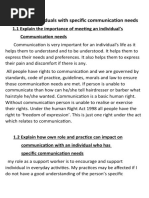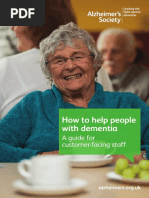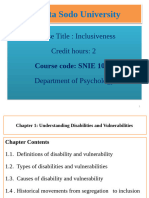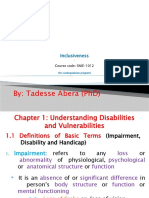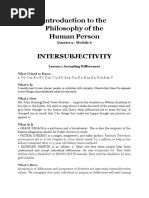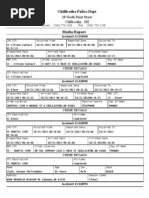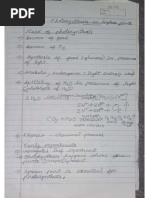0 ratings0% found this document useful (0 votes)
19 viewsNSTP Midterm Exam
NSTP Midterm Exam
Uploaded by
Pamela BelandresThe midterm exam evaluates participants' understanding of disability inclusion through multiple choice and essay questions covering topics such as defining common impairments, principles of inclusive disaster planning, etiquette for interacting with
Copyright:
© All Rights Reserved
Available Formats
Download as DOCX, PDF, TXT or read online from Scribd
NSTP Midterm Exam
NSTP Midterm Exam
Uploaded by
Pamela Belandres0 ratings0% found this document useful (0 votes)
19 views4 pagesThe midterm exam evaluates participants' understanding of disability inclusion through multiple choice and essay questions covering topics such as defining common impairments, principles of inclusive disaster planning, etiquette for interacting with
Original Title
- NSTP Midterm Exam
Copyright
© © All Rights Reserved
Available Formats
DOCX, PDF, TXT or read online from Scribd
Share this document
Did you find this document useful?
Is this content inappropriate?
The midterm exam evaluates participants' understanding of disability inclusion through multiple choice and essay questions covering topics such as defining common impairments, principles of inclusive disaster planning, etiquette for interacting with
Copyright:
© All Rights Reserved
Available Formats
Download as DOCX, PDF, TXT or read online from Scribd
Download as docx, pdf, or txt
0 ratings0% found this document useful (0 votes)
19 views4 pagesNSTP Midterm Exam
NSTP Midterm Exam
Uploaded by
Pamela BelandresThe midterm exam evaluates participants' understanding of disability inclusion through multiple choice and essay questions covering topics such as defining common impairments, principles of inclusive disaster planning, etiquette for interacting with
Copyright:
© All Rights Reserved
Available Formats
Download as DOCX, PDF, TXT or read online from Scribd
Download as docx, pdf, or txt
You are on page 1of 4
National Service Training Program
Midterm Examination
I. Multiple Choice: Write the letter before the number. (2pts.)
C 1. What is DiDRR?
a. Disability Inclusive Disaster Risk Reduces
b. Degrading Inclusive Disability Revise Risk
c. Disability Inclusive Disaster Risk Reduction
B 2. ADA means:
a. Africans with Disagree Act
b. Americans with Disabilities Act
c. Americans with Disable Authority
C 3. What is the Normal Vision of a Person?
a. 20/30
b. 30/40
c. 20/20
A 4. A group of eye condition that damage the optic nerve.
a. Glaucoma
b. Cataract
c. Macular degeneration
A 5. dense, cloudy area that forms in the lens of the eye.
a. Cataract
b. Normal Vision
c. Glaucoma
Essay: (10 pts. each number)
1. What are the 4 types of Impairments? Define each.
-The four types of impairments are:
• Physical Impairments – Difficulty in moving around or doing some
activities.
• Visual impairments - Difficulty in seeing and moving around.
• Hearing and Speech Impairments – Difficulty in hearing and
speaking.
• Intellectual and Mental Impairments – Difficulty in understanding
and behaving appropriately.
2. What are the 6 key principles in Disability-Inclusive Disaster Risk
Reduction?
- The six key principles in DiDRR are the following;
• Participation
• Twin- track Approach
• Comprehensive Accessibility and Universal Design
• “Building back better” Principle
• Non- discrimination
• Coordination and Collaboration
3. Give at least 3 Rules of Courtesy to the Blind?
-The following are some of the rules of courtesy to the blind:
•TALK - I’m an ordinary person, who happens to be blind. You can
talk to me as you would anyone else—no need to raise your voice. If
you have a question, please address me directly rather than asking my
companion.
• SEE – It’s ok to still use words such as see and look. I will talk with
you like everyone else, although I may not be able to make direct eye
contact.
• YIELD- In all 50 states, the law requires drivers to yield the right of
way when they see my extended white cane or guide dog. Only the
blind may legally carry white canes. Normally I can hear the sound of
traffic and will behave like any other pedestrian. If you drive a hybrid
or electric vehicle, I may not hear your car approach, so exercise
caution and use the horn if needed. You see more blind persons today
walking alone, not because there are more of us, but because we have
learned to make our own way.
4. What to do when you assist a Physical Impairment Person?
-If I am going to assist a Physically impaired person I will ask him/her
first before I will render my help because sometimes physically
impaired person can also be independent in their own ways. I will ask
him/her how can I help her/him or what kind of help she /he needs.
While helping I will also let him feel that we are both equal
individuals. I won’t show superiority to him/her. I will show him/her
equality. I will do my best to let her/him feel comfortable in my
assistance. Sometimes person with disabilities are grumpy so I will
give him/her patience and understanding.
5. Differentiate Legally Blind from Total blindness.
-Legally blind is refers to vision that is 20/200 or less in the
better eye that cannot be corrected with standard glasses or contacts
or a visual field of 20 degrees or less . Certain conditions like
glaucoma, cataracts, diabetic retinopathy, and macular degeneration
can cause one to be legally blind. Total blindness on the other hand is
defined as the complete lack of light perception, documented as no
light perception which means that total blindness cannot see
anything. It is often cause by genetic condition, disease or injury.
6. Identify what are the Basic Communication Principles when
Communicating with Person who are Deaf.
-The basic Communication Principles when Communicating with
deaf person are the following:
• Speak clearly.
-People who are deaf or have hearing loss can read lips. If you
speak clearly and project your voice (do not yell), they may need no
other help.
• Always make eye contact with the person, not his sign language
interpreter.
-It is very important that you have the conversation with the
person involved, not the sign language interpreter. By talking with
the interpreter, you are excluding the other person. Always talk with
him/her as you would with anyone else, the sign language interpreter
will take it from there.
• Write it down.
- If the communication is not working, you may write down your
messages to the person. However, it would be best to ask, in written
format, what he/she prefers before you have an entire conversation
on paper, especially because there may be simpler options.
7. Define Intellectually Challenged Person.
-Intellectually challenge person are those person who has certain
limitations in cognitive functioning and skills, including
communication, social and self-care skills. It is a condition in which
the brain doesn’t develop properly or function within the normal
range. The characteristics of an intellectually challenge person are;
mild to significant weaknesses in general learning ability, low
achievement in all academic areas, deficits in memory and
motivation, inattentive/distractible, poor social skills, and deficits in
adaptive behavior.
You might also like
- Support Individuals With Specific Communication NeedsDocument21 pagesSupport Individuals With Specific Communication NeedsRamona Lazurca100% (2)
- BDD Module 1 - Understanding2Document12 pagesBDD Module 1 - Understanding2Gil Eng MesquitaNo ratings yet
- Geological Survey of PakistanDocument12 pagesGeological Survey of PakistanshabbirNo ratings yet
- Involves The Exchange of Messages, Verbally and Nonverbally, Through Signals or WritingDocument16 pagesInvolves The Exchange of Messages, Verbally and Nonverbally, Through Signals or WritingArnoldoPovedaNo ratings yet
- Being DifferentDocument4 pagesBeing DifferentMustafa YacobeeNo ratings yet
- Inclusiveness chapter 1-4Document135 pagesInclusiveness chapter 1-4oronew0No ratings yet
- Disability SensitivityDocument41 pagesDisability Sensitivitymacmiranda136No ratings yet
- Special NeedsDocument35 pagesSpecial Needsmoira77No ratings yet
- Inclusive for HealthDocument145 pagesInclusive for Healthredwankiros29No ratings yet
- Inclusiveness - PPTTT ModifiedDocument212 pagesInclusiveness - PPTTT ModifiedlegeabreNo ratings yet
- Customer Facing Staff Guide DementiaDocument24 pagesCustomer Facing Staff Guide Dementiadionisio100% (1)
- APG Team Nila Courts 1 Disability AwarenessDocument44 pagesAPG Team Nila Courts 1 Disability AwarenessJingyi SaysHelloNo ratings yet
- Inclusiveness WSU CH 1 and 2Document94 pagesInclusiveness WSU CH 1 and 2Gutema MekonnenNo ratings yet
- Kendriya Vidyalaya EnglishDocument32 pagesKendriya Vidyalaya Englishvishali GNo ratings yet
- InclusivnessDocument183 pagesInclusivnessGetahun AbebawNo ratings yet
- InclusivnessDocument183 pagesInclusivnessmollalgnNo ratings yet
- Ch 1 Inclusivness May 2023Document52 pagesCh 1 Inclusivness May 2023yosefmuluye42No ratings yet
- Free SheenDocument5 pagesFree SheenAndyBarigaNo ratings yet
- DHS MediaGuides PrintDocument13 pagesDHS MediaGuides PrintVaishnavi JayakumarNo ratings yet
- By: Tadesse Abera (PHD) : InclusivenessDocument192 pagesBy: Tadesse Abera (PHD) : Inclusivenesswube hailuNo ratings yet
- Disability Awareness SensitivityDocument13 pagesDisability Awareness SensitivityPrithvi SetiaNo ratings yet
- Disability FinalDocument18 pagesDisability FinalcorneliusNo ratings yet
- Disability AwarenessDocument12 pagesDisability AwarenessIrtiza ChyNo ratings yet
- Inclusiveness ModuleDocument177 pagesInclusiveness ModuleAhmed AliNo ratings yet
- Questionnaire FinalDocument7 pagesQuestionnaire Finalapi-676636026No ratings yet
- Tips For Interacting With People With Mental Health DisabilitiesDocument3 pagesTips For Interacting With People With Mental Health DisabilitiesOltyxNo ratings yet
- 2e Everyone Is DifferentDocument24 pages2e Everyone Is DifferentCherry RipeNo ratings yet
- Inclusiveness CourseDocument100 pagesInclusiveness CourseNhial Nyachuol BolNo ratings yet
- DisabilitiesDocument7 pagesDisabilitiesMarihan MakramNo ratings yet
- CH 1 InclusivenessDocument80 pagesCH 1 InclusivenessnaolsafisaNo ratings yet
- Group No.08: Group Members Regula Dominick Daniel Urio Gido Focus Julius Saitore Vuai Denge Fred Luhangano John AkyooDocument31 pagesGroup No.08: Group Members Regula Dominick Daniel Urio Gido Focus Julius Saitore Vuai Denge Fred Luhangano John AkyooralphNo ratings yet
- Inclusiveness, Common CourseDocument179 pagesInclusiveness, Common Coursesewe3039No ratings yet
- Creating A Positive Environment and Communicating Effectively With People With DisabilityDocument3 pagesCreating A Positive Environment and Communicating Effectively With People With Disabilityapi-312493167No ratings yet
- Barriers To Communication: Appendix 2H02.02ADocument10 pagesBarriers To Communication: Appendix 2H02.02Ageet007_sawhneyNo ratings yet
- Inclusiveness All in OneDocument152 pagesInclusiveness All in OneGetahun AbebawNo ratings yet
- Unit 2: Definition, Types, Characteristics and Educational Needs of Children With DisabilitiesDocument16 pagesUnit 2: Definition, Types, Characteristics and Educational Needs of Children With DisabilitiesShwetaDaba .MBA2018EANo ratings yet
- Disability EtiquetteDocument1 pageDisability Etiquette7xnc4st2g8No ratings yet
- Inclusive pp4Document100 pagesInclusive pp4Rot RotNo ratings yet
- Inclusiveness Chap 1Document57 pagesInclusiveness Chap 1Teme DanaNo ratings yet
- Introduction To The Philosophy of The Human Person IntersubjectivityDocument6 pagesIntroduction To The Philosophy of The Human Person IntersubjectivityShevanie Lei AmamenceNo ratings yet
- Chap.1-PPT InclusivenessDocument38 pagesChap.1-PPT InclusivenessAnas MuhammedNo ratings yet
- Educating Learners Chapter 9Document50 pagesEducating Learners Chapter 9Allyssa Lorraine PrudencioNo ratings yet
- Inclusive All Chapter-1Document158 pagesInclusive All Chapter-1Addis YawkalNo ratings yet
- B. Module 1 ContentDocument7 pagesB. Module 1 ContentMartin GeorgievNo ratings yet
- Understanding Disabilities and VulnerabilitiesDocument32 pagesUnderstanding Disabilities and VulnerabilitiesdawitNo ratings yet
- Inclusiveness Premed 16 MC AssignmentDocument26 pagesInclusiveness Premed 16 MC AssignmentDeborah BereketNo ratings yet
- InculcveDocument161 pagesInculcvebirhanuteshome84No ratings yet
- Inclusiveness: Prepared By: Dinke A. 2021Document131 pagesInclusiveness: Prepared By: Dinke A. 2021maria tafaNo ratings yet
- Mental RetardationDocument90 pagesMental Retardationfatima ombalNo ratings yet
- Issues and Challenges.Document18 pagesIssues and Challenges.tejendra nathNo ratings yet
- Overview of DisabilityDocument47 pagesOverview of DisabilityDr. Ranjan KumarNo ratings yet
- Definition of Basic Terms: ImpairmentDocument221 pagesDefinition of Basic Terms: ImpairmentHULE ADDIS ENTERTAINMENTNo ratings yet
- Challenges Faced by The ChallengedDocument15 pagesChallenges Faced by The ChallengedSweta Verma Sunder93% (14)
- Blind Charity OrganizationDocument14 pagesBlind Charity Organizationnavjyot AndhjanNo ratings yet
- Children With Special NeedsDocument14 pagesChildren With Special NeedsBiswajit RoutNo ratings yet
- What Is Sensory Impairment: 1 Reading Services GuideDocument16 pagesWhat Is Sensory Impairment: 1 Reading Services GuideJohn Paul EsplanaNo ratings yet
- Inclusiveness 1&2&3Document88 pagesInclusiveness 1&2&3yohannes tubeNo ratings yet
- Philo 13 PwdDocument16 pagesPhilo 13 PwdClydell AdventajadoNo ratings yet
- Q2 SLHT6Document13 pagesQ2 SLHT6ALEX SARAOSOSNo ratings yet
- Concrete Technology Lab-Manual 2024Document21 pagesConcrete Technology Lab-Manual 2024Shani BalochNo ratings yet
- Lecture Session Six (1) 2Document21 pagesLecture Session Six (1) 2Keith GregoryNo ratings yet
- Zirconia in DentistryDocument37 pagesZirconia in Dentistryasha docNo ratings yet
- Chapter 39 - Teacher's ManualDocument14 pagesChapter 39 - Teacher's ManualHohoho100% (1)
- 6310 0 0160 6352 825 101 Bottom End Strip With Temperature Sensor Glass Black Busch Prion CDocument2 pages6310 0 0160 6352 825 101 Bottom End Strip With Temperature Sensor Glass Black Busch Prion Caugusto maldonadoNo ratings yet
- Ped Guidelines - g7 - 17Document2 pagesPed Guidelines - g7 - 17Stefano FavaroNo ratings yet
- Process Lines For Crude Palm Oil Production - tcm11 55437 PDFDocument24 pagesProcess Lines For Crude Palm Oil Production - tcm11 55437 PDFLim Zamora Gemota100% (1)
- Dialog, Spare PartDocument70 pagesDialog, Spare PartSalwa MarhainiNo ratings yet
- Ns. Tony Suharsono, M Kep: Curriculum VitaeDocument7 pagesNs. Tony Suharsono, M Kep: Curriculum VitaehaliliNo ratings yet
- Effect of Various Heat Treatment On The Mechanical Properties of Steel Alloy EN31Document10 pagesEffect of Various Heat Treatment On The Mechanical Properties of Steel Alloy EN31IJIRSTNo ratings yet
- Section 3 - Maintenance Instruction - ZPMCDocument38 pagesSection 3 - Maintenance Instruction - ZPMCGer Bos100% (1)
- 07 Income From Property (50 59)Document11 pages07 Income From Property (50 59)jafferyasim100% (2)
- Exalted Gambler: Author: Special Thanks ToDocument2 pagesExalted Gambler: Author: Special Thanks ToAlfa CoachingNo ratings yet
- Chillicothe Police Reports For October 22nd 2013Document28 pagesChillicothe Police Reports For October 22nd 2013Andrew AB BurgoonNo ratings yet
- Social Media Use and Academic Performance of StudentsDocument44 pagesSocial Media Use and Academic Performance of StudentsmargaretteolbesNo ratings yet
- Omeik MotorDocument2 pagesOmeik MotornmulyonoNo ratings yet
- DownloadDocument6 pagesDownloadKeyur GandhiNo ratings yet
- Lesson Planning Worksheet: ADDIE Instructional DesignDocument4 pagesLesson Planning Worksheet: ADDIE Instructional Designapi-346169389No ratings yet
- Prospective Stable Grid Float Use CasesDocument10 pagesProspective Stable Grid Float Use CasesFareeha IrfanNo ratings yet
- VoluteDocument1 pageVoluteM Ferry AnwarNo ratings yet
- History: NTC Regional Office 5Document2 pagesHistory: NTC Regional Office 5HohenheimNo ratings yet
- ComicstripandvideorubricDocument2 pagesComicstripandvideorubricapi-480153144No ratings yet
- Howard Botwinick, Persistent Inequalities (2017)Document386 pagesHoward Botwinick, Persistent Inequalities (2017)Virgilio Urbina LazardiNo ratings yet
- Thesis On Mobile Cloud ComputingDocument5 pagesThesis On Mobile Cloud Computinglisadiazsouthbend100% (1)
- AiDocument28 pagesAiGobiNo ratings yet
- Taner & Antony, 2006Document11 pagesTaner & Antony, 2006شبلي غرايبهNo ratings yet
- Sankalp Monthly Test Notice (Class 11)Document1 pageSankalp Monthly Test Notice (Class 11)navansh bansalNo ratings yet
- What Are The Adequate Pedagogical Approaches For Teaching Scientific Disciplines? Physics As A Case StudyDocument8 pagesWhat Are The Adequate Pedagogical Approaches For Teaching Scientific Disciplines? Physics As A Case StudycriselNo ratings yet
- Photosynthesis in higher plants by Manoj dole sir aakashDocument40 pagesPhotosynthesis in higher plants by Manoj dole sir aakashsaruNo ratings yet
